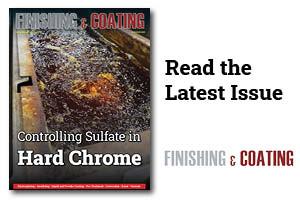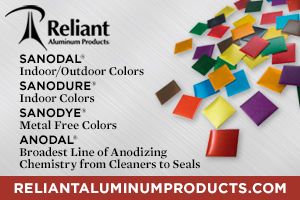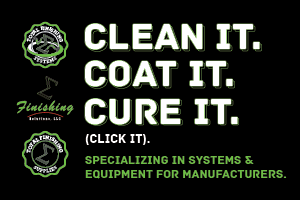Chrome deposit stripping is a crucial component of any plating operation.
 Eric Svenson Sr.Both job shops and captive shops need this capability, regardless of their size or type of plating they perform. Having the ability to effectively strip chrome deposits is necessitated by two requirements:
Eric Svenson Sr.Both job shops and captive shops need this capability, regardless of their size or type of plating they perform. Having the ability to effectively strip chrome deposits is necessitated by two requirements:
- To correct rejects by removing inferior deposits before replating.
- For processing rebuilt parts where the chrome deposit must be removed before repairing the substrate and replating, this process is used.
Chrome deposit stripping is just as important as the plating steps and should be done with the same care and expertise. The objective is to remove the chromium deposit without damaging the base metal; the stripper should only react with the chromium deposit and not against the substrate. Depending on the operation, the stripping process can require as much floorspace as the plating sequence does.
Many hard chrome-plated parts are valuable and costly to replace; this eliminates the need to discard and replace them with new ones. The discard-and-replace mentality also runs counter to the principles of environmentalism, as it wastes valuable resources. When done properly and for the right reasons, stripping can be beneficial to both the economy and the environment.
Cost of Stripping
 A modern stripping operation.Most rebuilt parts require chrome deposit stripping, so this is unavoidable and becomes part of the overall repair cost. However, stripping caused by excessive rework requirements is a different story because it adds considerably to the operational overhead. A well-managed hard chrome operation, plating production parts, should have a reject rate of around 2% or lower. Complex parts and those with unknown base metals will have a somewhat higher reject rate.
A modern stripping operation.Most rebuilt parts require chrome deposit stripping, so this is unavoidable and becomes part of the overall repair cost. However, stripping caused by excessive rework requirements is a different story because it adds considerably to the operational overhead. A well-managed hard chrome operation, plating production parts, should have a reject rate of around 2% or lower. Complex parts and those with unknown base metals will have a somewhat higher reject rate.
Any stripping requirement beyond this is considered excessive and requires investigation to determine the cause and eliminate or reduce it. Unwarranted stripping triples the production costs (3-X), as a minimum. The actual cost is likely higher because of lost inspection, preparation, and production time.
Causes for Excessive Stripping
Unwarranted stripping caused by high rework requirements is expensive and contributes to high overhead costs. Excessive stripping can be caused by several irregularities in the chrome deposit, including:
- Roughness, nodules, or trees.
- Poor Cr deposit uniformity.
- Insufficient coverage.
- Poor adhesion and blisters.
- Excessive pitting.
- Discoloration or dark spots.
- Unacceptable thickness (in some cases).
Typical Stripping Cycle
Most stripping operations use a process cycle similar to what’s used for plating. This can vary with the base metal and metallurgy involved, but the following is typical:
- Initial inspection to determine that stripping is needed.
- Surface cleaning (degreasing) to remove any surface oils.
- Stop-off, if needed, for areas that could be damaged.
- Fixturing
- Deposit stripping.
- Rinsing
- De-fixturing & de-masking, if used.
- Drying
- Surface refinishing, such as polishing.
A stop-off may be needed for areas that the stripping process might damage, or to create a suitable deposit in certain parts of the part. The part should be rinsed thoroughly after stripping to avoid any plating bath drag-in. Polishing is almost always necessary after stripping and before replating due to minor changes in the surface finish.
Two Types of Chrome Strippers
The composition of a stripper must be strong enough to remove the metal deposit, yet not dissolve or damage the base metal. There are two types of strippers suitable for hard chrome deposits: the acidic immersion type and the alkaline electrolytic type. It’s also possible to strip chrome by reversing the plating process in the plating bath, but this is never recommended because it can easily damage the base metal, causing severe pitting, while also adding trivalent and iron to the bath.
The stripping operation should be precise, accurate, and as well managed as the plating process is. The best stripper type to use depends on the base metal involved. It is a mistake to use the wrong type of stripper, as this could easily damage the substrate with unrepairable pits, corrosion, or even dissolve the base metal. A job shop that processes a variety of metals is thus well served by having both stripper types available. Each stripper type has its purpose as outlined below.
Acid Immersion Stripper: The acid stripper removes the chrome deposit by dissolution. The acid will damage steel base metals, so it should not be used for ferrous alloys. This stripper is designed specifically for stripping brass, bronze, beryllium, carbide, copper, Ferrotic, Inconel, Monel, nickel alloys, silver solder, and stainless-steel alloys having high levels of chromium and nickel, such as type 316.
Never strip aluminum or zinc substrates with the acid stripper, as these materials will dissolve easily. Aluminum is best stripped by reverse etching in a chromic acid bath, free of fluorides. Zinc-based metals must be stripped by either polishing or grinding.
The acid chrome stripper bath should contain:
- 25% by volume Hydrochloric acid 20° Be’ (10 - 40% range)
- 3% by volume Inhib-All
Higher acid concentrations result in somewhat faster stripping rates, and vice versa; however, the 25% level appears to work well for most applications. Inhib-All is an inhibitor that helps protect from base metal damage and assists with stripping uniformity. It also provides a foam blanket during stripping that helps control the fuming.
The bath is operated at ambient temperatures and should never be heated. The stripping rate for a fresh bath is typically around 0.00030”/hour, and this slows to around 0.00015”/hour after being in use for some time. The bath should be controlled by analysis of the acid content, with routine additions made accordingly.
One considerable downside of the acid bath is the intolerable fumes of acid it constantly generates. An adequate ventilation system is mandatory, and the tank should have a lid that stays closed except when adding or removing parts. The acid fumes will still corrode steel components in the plant, such as roof trusses and superstructures, even when these precautions are used.
Another downside is that the hydrochloric acid is consumed at a fast rate, so the bath needs to be dumped and replaced fairly often.
Alkaline Electrolytic Stripper: The alkaline electrolytic stripper removes chrome through electrolysis, where the part is made the anode and the chrome plates off into the stripper bath. It does not plate onto the cathodes, but stays dissolved in the solution. It is used for steel base metals and stainless-steel alloys, such as type 304, which have low chromium and nickel levels. This stripper should contain:
- 25 oz./gallon of Polystrip-26 (15 - 50 range)
That’s it, just a single ingredient that’s easy to control and work with. The bath is typically operated at 140°F with a current density of only 1 A/cm². The parts being stripped are made anodic, i.e., reversed. The cathodes can be steel, stainless steel, or even the bare steel tank walls themselves. This bath has an incredibly fast stripping rate of around 0.003”/hour.
When stripping several parts simultaneously, it’s beneficial to use multiple bays within the tank or have individual steel cathodes on adjustable bus bars. This provides faster stripping rates by eliminating the electrical shading effect that one part would have on another.
This bath performs much better than the old-school home brew using caustic soda. It strips faster, removes the chrome deposit more uniformly, protects the base metal, and lasts much longer. Another advantage is that the parts can be stored in it for a long time after stripping, if needed, and used as a staging area to prevent rusting.
The Polystrip-26 bath enjoys an exceptionally long lifespan and rarely requires discarding or replacement. That’s because it is formulated to hold tremendous amounts of the chrome that has been stripped. It is maintained by simply making Polystrip-26 additions as needed to maintain the 25 oz./gallon level. The only caution is to avoid chloride contamination, typically from hydrochloric acid or the water supply, as high chloride levels can cause pitting in the base metal.
The benefits of using Polystrip-26 include the absence of base metal damage, a fast-stripping rate, and an extremely long bath life that’s easy to maintain and control. This bath can also serve a double purpose by using it to clean lead anodes and for removing chrome stains. There’s nothing wrong with having a dual-purpose tank, even though the AnoBest-104 process cleans lead anodes more efficiently.
Polishing After Stripping
Most steel alloys will darken after stripping because some of the carbon is brought to the surface. This is especially true with alloys having a higher carbon content. This is normal and happens regardless of whether the acid or alkaline stripper was used. All parts should be polished after stripping to remove this carbon and provide the desired surface finish before replating.
Surface Testing After Stripping
Sometimes, it’s difficult to determine when all the chrome deposit has been removed after stripping, especially on highly polished base metals. A simple test is applying a blue vitriol solution to a clean and dry area of the part using a Q-Tip or a rag. Rub the blue vitriol on the questionable area and observe the result. A fully stripped spot will take on a visible copper color, while a spot that still has a chrome deposit will not change color.
Eric Svenson Sr. is CEO of Plating Resources and a Master CEF and IUSF member. Visit www.Plating.com. If you have any questions or wish to explore this topic further, please contact Vicky at Vicky@Plating.com.



































